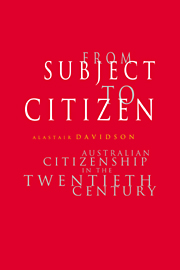PART I - From Subject to Citizen 1901–1996
Published online by Cambridge University Press: 06 January 2010
Summary
The first four chapters of this book trace the progress from the status of ‘subjects’ of the British monarch which Australia's inhabitants had in 1901 to that of ‘citizens’ of Australia which they enjoy in 1996.
Citizenship had a long history before Australia was occupied by the whites. The Australian people (s) inherited part of that history and developed on it. It also continued in parallel fashion elsewhere, to be known and learnt about by the inhabitants of Australia. Its basic ingredients are discussed in chapter 1. These ingredients were established in a structure long ago in the Greek city-states: a citizen was someone who had full and equal rights to decide what measures should be taken to attain the collective good for all citizens; the citizens deciding on and acting for the collective good thus formed a community. The size of the community – the space over which its notion of the good extended – was then one small city, some of whose inhabitants ‘belonged’ in the community. A citizen was thought of as if he were a family member, since who could ‘belong’ to the community was a family member linked by kinship ties.
However, as we show, the communitarian model was superseded when the nation-state replaced the city state in Europe in the fifteenth to twentieth centuries. Then the size of the political community became much bigger. It could no longer be mediated or thought of as united by kinship ties. In its place was created a fictitious community, the nation of citizens who might never know each other.
- Type
- Chapter
- Information
- From Subject to CitizenAustralian Citizenship in the Twentieth Century, pp. 9 - 12Publisher: Cambridge University PressPrint publication year: 1997



